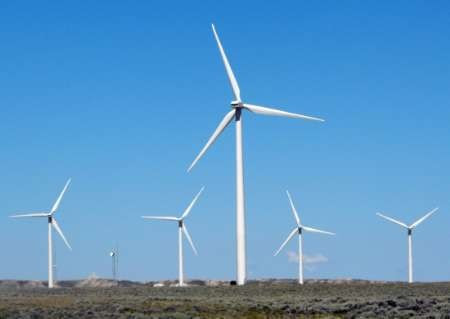An age-old renewable causes a nuclear fallout

It was a glorious, sunny day as I took my wife and kids to the Kasteel Meulen (Castle Mill) at the very top of the village of Mont Cassel, about 18 miles from Dunkerque. My children were excited to see a working windmill but, regrettably, there was not a breath of wind in the shimmering mid-summer heat and so, Blue Peter-like, we had to buy a bag of flour that the miller had already made.
The next day and we went off to see one of Europe's oldest operating windmills, the Noordmeulen dating from 1127, in the nearby small town of Hondschoote - in this part of France many people still speak Flemish as their first language. Yet again, we had to look upon a windmill all out of puff.
Some 10 years later at Christmas 2003 whilst staying in Hamburg, I remembered the family's holiday in Northern France when, having to take the train to Bremen, I looked at the inert sails of a wind farm on the approach to that city, in the chill, still and clear morning air. I thought that if my medieval counterpart had been able to look out that same train window, he would have remarked: "No change there then!"
A modern wind turbine is designed with an operational life of about 25 years and over the course of a year will generate about 30 per cent of its theoretical maximum output, generally known as its load or capacity factor, with better results for off-shore (up to 33 per cent) than on-shore (around 27 per cent). Economic wind generators need a wind speed of over 10mph but are shut down at 50-55mph to avert damage to the turbines. Long and careful study with regards to optimum location is required, which often takes a year, as a small distance of just 10 yards in the location of a turbine can have a dramatic effect on its energy output and financial return.
Scotland has not had a great summer so far but Scottish Renewables are happy for the weather has delivered a record output at the country's 115 wind farms with an onshore load factor at 60 per cent recorded for May 2011, more than double the norm.
Yet despite all this uncertainty, wind energy is one of the basic forms of power that Germany, and now Japan, where only 19 of its 54 nuclear reactors are currently operating, intends to make a key feature of the country's energy mix.
Closer to home, it forms a major plank in SNP Leader, Alec Salmond's "Green", "No to Nuclear" credentials, but as the Scottish edition front page headline-story in The Times on 16 June 2011 makes clear: "Renewable energy bill soars as delays bite", this doesn't come cheap. Costs are rising rapidly, new ones keep coming to light and the technology is not yet fully proven. The Times quotes that the latest estimate of the Beauly to Denny power transmission line as £600 million, a very steep rise from the £300 million reported in the media just earlier this year.
The obvious disadvantage of wind energy is when there is no wind to power the turbines, often experienced during periods of high pressure as my trips in France and Germany relate. There can also be frequent changes of wind speed over a relatively short time frame when the wind is blowing, causing dips and surges in energy produced. For the foreseeable future, this will mean a back-up energy source - gas, coal or nuclear - and starting from the present, the adaptation of the electricity grid in most countries in Europe to cope with and store, current produced during surges or times of mismatch in energy supply and demand.
Operating power stations on a stand-by basis is both expensive and inefficient. Adapting the grid will be expensive too, not to mention the building of the infrastructure required to carry the energy from the wind source to the required sites of industry - in Germany's case the Baltic and North Sea coasts to the Rhine-Ruhr and south to Bavaria.
The political decision to close down its nuclear industry in little more than 10 years, means that Germany has to bite this particular bullet before it is really necessary or properly costed and, first to adopt such drastic action, all eyes are looking to see whether one of the world's biggest economies and exporters, can really pull this feat off.
Even trying, is causing German industry and not a few politicians deep concern, partly on the grounds that renewables will not be able to fill the gap (23 per cent) presently being filled by nuclear but also at what cost disadvantage, particularly in its manufacturing and export sector, in comparison to its competitors.
The cost to Germany following the decision to close down its nuclear industry is not only financial but political. Chancellor Angela Merkel had been widely quoted as saying fairly recently, that the closure of technically safe nuclear reactors was "absurd". Only last October 2010, did the German Government push through legislation reversing that of its predecessor by extending the use of nuclear power to 2033.
In probably the biggest U-turn in modern German political history, Chancellor Merkel, on 09 June 2011, urged the country's lawmakers to back the legislation required to: "...lead the world in removing nuclear energy." Rightly, the Opposition is highly sceptical and critical of Mrs Merkel's late conversion to wind and solar energy. In truth, the change of heart is more than likely the result of electoral setbacks suffered by the governing coalition at the hands of the SDP/Green's Alliance than a damaged Japanese nuclear reactor hit by a 9.0 magnitude earthquake and a quickly following tsunami.
Judy Dempsey of the New York Times quoted Mrs Merkel's 09 June 2011 address: "...We all can work together on this project to combine future ethical responsibilities with economic success...." The discovery of the moral high ground! With 58 nuclear reactors generating 61,000 megawatts and accounting for 75 per cent of its electricity produced, this surely is a snub aimed at France!
The German Government has eight new bills in the pipeline designed to enable the transition to the likes of wind and solar energy but included in this legislation and crucial to filling an expected energy shortfall, are laws to speed up the construction of fossil fuel power plants. Ah well, Germany's powerful "green" lobby can't have it all their own way!
Quiz time. What do RWE, E.on, EnBW and Vattenfall all have in common?
Answer: They are four of Germany's biggest utilities companies with a considerable stake in the country's nuclear industry.
Here's a few more companies: Clifford Chance, Linklaters, Freshfields Bruckhaus Deringer and Gleiss Lutz. No? Don't ring a bell? They might in future in the finance and legal press for these are the law firms that the aforementioned utility companies are appointing to mount a challenge against the Federal German Government and its nuclear closure programme. Should be very interesting!
© Copyright IBTimes 2025. All rights reserved.





















